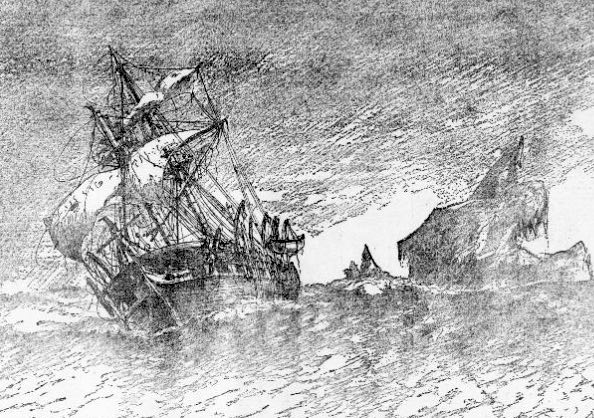This newspaper article explains how some ghost ship sighting were just rocks jutting out of the water combined with fog or strange weather events. It is a reasonable assumption, but I don’t think it explains away all of the ghost ship sighting events.

The Ghost Ship of Cape Horn
From The Daily Democrat. April 3, 1907.
Another blow against time honored traditions has been struck by the iconoclasts of science. The United States hydrographic office has calmly declared that the phantom ship seen in the vicinity of Cape Horn, the “ghost ship of Le Maire,” is nothing more nor less than a rock which under certain atmospheric conditions bears a deceptive resemblance to a ship.
Very often ships coming from Europe to the west by way of Cape Horn have been startled to see what seemed to be a derelict with the water washing over her decks. If the sailors were of an imaginative turn of mind they would invest the unknown ship with ghostly qualities and call her the Flying Dutchman or sometimes the ghost ship of Le Maire, from the strait of that name, where she was usually seen.
One of the stories which have been longest remembered is that of the ill-fated Crown of Italy, which sighted the supposed derelict and subsequently went ashore. The Crown of Italy was standing close to the jagged black rocks at the entrance to the Strait of Le Maire when she sighted what seemed to be a water logged bark drifting on the rocks of the strait. Many other ships rounding the Horn have seen a similar apparition and the hydrographic office has received many reports to that effect.
Not long ago the Norwegian bark Servia came into Seattle with the tale of a phantom ship which almost exactly corresponds to that given by the Crown of Italy. The second officer of the Norwegian vessel declared that he had seen a reelect with sails set and decks awash drifting in through the strait. It was this report which led the hydrographic office to make public the declaration that the phantom ship was nothing but a combination of rocks and shadows.
It seems that the numerous reports of derelicts or ghost ships always appearing in about the same place led even the Argentine government to bestir itself. A tender was sent out from the nearby lighthouse with the object of making an investigation, and it was found that the apparition was due to a strange freak of nature. Among the black, jagged rocks that lined both sides of the Strait of Le Maire there was one in particular which, under certain atmospheric conditions, bore a deceptive likeness to a ship. The formation of the rocks and the shadows they cast combined to produce the effect of a bark running under short sails. At a distance of five miles the place will be marked with the words “Rock bearing the appearance of a ship.”
The passage through the Strait of Le Maire is not often made. Steamers shorten the route by going through the Strait of Magellan, while sailing vessels usually prefer to be entirely on the safe side by going still further south and rounding the Horn itself. Only under the most favorable weather conditions do they slip through the Strait of Le Maire on the outward trip, going toward the southwest, but never when bound for the north. For this reason many old sailors have never met the ghost ship or the rock ship.
Upon making inquiry among old sailors of San Francisco, however, several were found who could give a minute description of the rock and who testified to its striking resemblance to a ship. It seems to be standing head on, pointing to the south and low in the water. The sails are shortened as they would be in what sailors call half a gale. The whole formation is very dark, as if the hull were painted black and the sails weather beaten. It has three masts and is higher on the fore than on the main. Upon coming on the side of the vessel the illusion vanishes and the whole thing resolves itself into a conglomeration of black rocks. The perpetual fog of those regions of course helps to befuddle the vision.
The rock looking like a ship is by no means a rare natural formation. Almost every sailor has seen one in some part of the world. In the Clipperton islands there is a great white rock looking like a three masted schooner, leaning on the wind with her royals set and the run shining on her white sails. About six or seven miles west of Honolulu there is a rock known as French Frigate rocks, because once upon a time a French frigate went ashore on it. The cliffs looked so much like a ship that the frigate was deceived and thought she was meeting another ship. St. Paul island in the middle of the Atlantic is said to look very much like a ship when approached from a certain direction, but it is a place which mariners prefer to give a wide berth.

